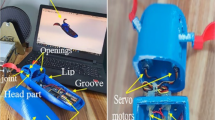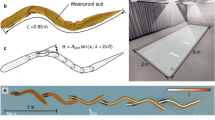Abstract
This article presents a design of a novel swimming mechanism based on a linkage mechanism. The generated motions of the proposed mechanism mimic the purely aquatic locomotion of frogs such as Xenopus laevis (X. laevis), including both the motions of the hind legs and the webbed foot. A six-bar linkage mechanism is employed in this study combing with a spatial linkage mechanism to simplify the overall mechanism. Attributes to the optimal design, the number of Degrees of Actuations (DoA) reduces to two in each hindlimb, which realizes miniaturization in the current study. Kinematic analysis is conducted to analyze the locomotion of the spatial mechanism. The hydrodynamic model based on the blade element theory is established to estimate the swimming performance of the designed mechanism. The peak thrust (approximately 0.2 N) is dramatically larger than the minimum drag (−0.023 N) observed in the experiment which increases the efficiency of the prototype’s swimming.
Similar content being viewed by others
Data Availability
Not Applicable.
References
Park, H.S., Floyd, S., Sitti, M.: Roll and pitch motion analysis of a biologically inspired quadruped water runner robot. Int. J. Robot. Res. 29(10), 1281–1297 (2010). https://doi.org/10.1177/0278364909354391
Ramezani, A., Chung, S., Hutchinson, S.: A biomimetic robotic platform to study flight specializations of bats. Sci. Robot. 2(3), Art-No (2017)
Kim, S., Spenko, M., Trujillo, S., Heyneman, B., Santos, D., Cutkoskly, M.R.: Smooth vertical surface climbing with directional adhesion. IEEE Trans. Robot. 24(1), 65–74 (2008). https://doi.org/10.1109/TRO.2007.909786
Zhong, Y., Li, Z., Du, R.: A novel robot fish with wire-driven active body and compliant tail. IEEE/ASME Trans. Mechatronics. 22(4), 1633–1643 (2017). https://doi.org/10.1109/TMECH.2017.2712820
Colorado, J., Barrientos, A., Rossi, C., Breuer, K.: Biomechanics of smart wings in a bat robot morphing wings using SMA actuators. Bioinspir. Biomim. 7(3), 036006 (2012). https://doi.org/10.1088/1748-3182/8/1/019501
Jansson, N., Bale, R., Onishi, K., Tsubokura, M.: Optimizing the structure and movement of a robotic bat with biological kinematic synergies. Int. J. Robot. Res. 37(10), 1233–1252 (2018). https://doi.org/10.1177/ToBeAssigned
Floyd, S., Keegan, T., Palmisano, J., Sitti, M.: A novel water running robot inspired by basilisk lizards. IEEE Int. Conf. Intell. Robot. Syst. 1, 5430–5436 (2006). https://doi.org/10.1109/IROS.2006.282111
Kim, H., Lee, D., Jeong, K., Seo, T.: Water and ground-running robotic platform by repeated motion of six spherical footpads. IEEE/ASME Trans. Mechatronics. 21(1), 175–183 (2016). https://doi.org/10.1109/TMECH.2015.2435017
Park, H.S., Sitti, M.: Compliant footpad design analysis for a bio-inspired quadruped amphibious robot. 2009 IEEE/RSJ Int. Conf. Intell. Robot. Syst. IROS. 2009, 645–651 (2009). https://doi.org/10.1109/IROS.2009.5354680
Crespi, A., Karakasiliotis, K., Guignard, A., Ijspeert, A.J.: Salamandra Robotica II: an amphibious robot to study salamander-like swimming and walking gaits. IEEE Trans. Robot. 29(2), 308–320 (2013). https://doi.org/10.1109/TRO.2012.2234311
Karakasiliotis, K., Thandiackal, R., Melo, K., Horvat, T., Mahabadi, N.K., Tsitkov, S., Cabelguen, J.M., Ijspeert, A.J.: From cineradiography to biorobots: An approach for designing robots to emulate and study animal locomotion. J. R. Soc. Interface. 13, 119 (2016). https://doi.org/10.1098/rsif.2015.1089
Aerts, P., Nauwelaerts, S.: Environmentally induced mechanical feedback in locomotion: frog performance as a model. J. Theor. Biol. 261(3), 372–378 (2009). https://doi.org/10.1016/j.jtbi.2009.07.042
Pandey, J., Reddy, N.S., Ray, R., Shome, S.N.: Biological swimming mechanism analysis and design of robotic frog. 2013 IEEE Int. Conf. Mechatronics Autom. IEEE ICMA. 2013, 1726–1731 (2013). https://doi.org/10.1109/ICMA.2013.6618176
Johansson, L.C., Lauder, G.V.: Hydrodynamics of surface swimming in leopard frogs (Rana pipiens). J. Exp. Biol. 207, 3945–3958 (2004). https://doi.org/10.1242/jeb.01258
Fan, J.Z., Zhang, W., Kong, P.C., Cai, H.G., Liu, G.F.: Design and dynamic model of a frog-inspired swimming robot powered by pneumatic muscles. Chinese J. Mech. Eng. English Ed. 30(5), 1123–1132 (2017). https://doi.org/10.1007/s10033-017-0182-5
Fan, J., Wang, S., Yu, Q., Zhu, Y.: Swimming performance of the frog-inspired soft robot. Soft Robot. 7(5), 615–626 (2020). https://doi.org/10.1089/soro.2019.0094
Richards, C.T.: The kinematic determinants of anuran swimming performance: an inverse and forward dynamics approach. J. Exp. Biol. 211(Pt 19), 3181–3194 (2008). https://doi.org/10.1242/jeb.019844
Y. Tang, L. Qin, X. Li, C. Chew, and J. Zhu: A frog-inspired swimming robot based on dielectric elastomer actuators. In 2017 IEEE/RSJ International Conference on Intelligent Robots and Systems (IROS), 2017, pp. 1–6
O’Brien, B., Calius, E., Xie, S., Anderson, I.: An experimentally validated model of a dielectric elastomer bending actuator. Proc. SPIE 6927. 6927, 69270T–69270T–11 (2008). https://doi.org/10.1117/12.776098
O’Brien, B., McKay, T., Calius, E., Xie, S., Anderson, I.: Finite element modelling of dielectric elastomer minimum energy structures. Appl. Phys. A Mater. Sci. Process. 94(3), 507–514 (2009). https://doi.org/10.1007/s00339-008-4946-8
Zhao, J., et al.: Equivalent dynamic model of DEMES rotary joint. Smart Mater. Struct. 25(7), 75025 (2016)
Kargo, W.J., Nelson, F., Rome, L.C.: Jumping in frogs: assessing the design of the skeletal system by anatomically realistic modeling and forward dynamic simulation. J Exp Biol. 205(12), 1683–1702 (2002) [Online]. Available: http://www.ncbi.nlm.nih.gov/pubmed/12042328
A. J. Collings, L. B. Porro, C. Hill, and C. T. Richards: The impact of pelvic lateral rotation on hindlimb kinematics and stride length in the red-legged running frog, Kassina maculata. R. Soc. Open Sci., vol. 6, no. 5, 2019. https://doi.org/10.1098/rsos.190060
Kargo, W.J., Rome, L.C.: Functional morphology of proximal hindlimb muscles in the frog Rana pipiens. J. Exp. Biol. 205(2002), 1987–2004 (2002)
Haldane, D.W., Plecnik, M.M., Yim, J.K., Fearing, R.S.: Robotic vertical jumping agility via series-elastic power modulation. Sci. Robot. 1(1), eaag2048 (2016). https://doi.org/10.1126/scirobotics.aag2048
Richards, C.T.: Kinematics and hydrodynamics analysis of swimming anurans reveals striking inter-specific differences in the mechanism for producing thrust. J. Exp. Biol. 213(4), 621–634 (2010). https://doi.org/10.1242/jeb.032631
Richards, C.T., Clemente, C.J.: Built for rowing: frog muscle is tuned to limb morphology to power swimming. J. R. Soc. Interface. 10, 20130236 (2013). https://doi.org/10.1098/rsif.2013.0236
Plecnik, M.M., Michael McCarthy, J.: Numerical Synthesis of Six-Bar Linkages for Mechanical Computation. J. Mech. Robot. 6(3), 031012 (2014). https://doi.org/10.1115/1.4027443
Plecnik, M.M., McCarthy, J.M.: Kinematic synthesis of Stephenson III six-bar function generators. Mech. Mach. Theory. 97, 112–126 (2016). https://doi.org/10.1016/j.mechmachtheory.2015.10.004
Plecnik, M.M., McCarthy, J.M.: Design of Stephenson linkages that guide a point along a specified trajectory. Mech. Mach. Theory. 96, 38–51 (2016). https://doi.org/10.1016/j.mechmachtheory.2015.08.015
Plecnik, M.M., McCarthy, J.M.: Computational Design of Stephenson II six-Bar function generators for 11 accuracy points. J. Mech. Robot. 8(1), 1–9 (2016). https://doi.org/10.1115/1.4031124
Huang, H., Brown, D.D.: Overexpression of Xenopus laevis growth hormone stimulates growth of tadpoles and frogs. Proc. Natl. Acad. Sci. U. S. A. 97(1), 190–194 (2000). https://doi.org/10.1073/pnas.97.1.190
Kashem, S.B.A., Jawed, S., Ahmed, J., Qidwai, U.: Design and implementation of a quadruped amphibious robot using duck feet. Robotics. 8(3), 77 (2019). https://doi.org/10.3390/robotics8030077
S. Guo et al.: Basic characteristics evaluation of a duck-like robot. Proc. 2019 IEEE Int. Conf. Mechatronics Autom. ICMA 2019, pp. 1502–1507, 2019. https://doi.org/10.1109/ICMA.2019.8816536
Gal, J.M., Blake, R.W.: Biomechanics of frog swimming I. estimation of the force generated by Hymenochirus boettgeri. J. Exp. Biol. 138, 399–411 (1988)
Funding
This work was supported by the National Key R&D Program of China (2018YFB2001303), the National Natural Science Foundation of China (Grant No. 52075267), the Natural Science Foundation of Jiangsu Province (Grant no. BK20210341), Grant the Fundamental Research Funds for the Central Universities (Grant No. 309201A8801), and the Open Fund of State Key Laboratory of Intelligent Manufacturing System Technology.
Author information
Authors and Affiliations
Contributions
Yucheng Tang conceived the presented idea of the mechanism and organized the whole paper. Xiaolong Yang built the inversed kinematic modeling. Wei Liu built the CAD model and analyzed the assembly simulation. Lizhi Qi proposed multi-objective optimization and selected the design parameters. Yan Wang calculated the kinematic simulation of the designed mechanism. Yulin Wang analyzed the functions of the mechanism and he was responsible for planning and coordinating the steps of the research.
Corresponding author
Ethics declarations
This paper does not report research that requires ethical approval. Consent to participate or consent to publish statements is accordingly also not required.
Competing Interests
The authors declare that they have no known competing financial interests or personal relationships that could have appeared to influence the work reported in this paper.
Additional information
Publisher’s Note
Springer Nature remains neutral with regard to jurisdictional claims in published maps and institutional affiliations.
Rights and permissions
About this article
Cite this article
Tang, Y., Yang, X., Liu, W. et al. Design and Analysis of a Novel Swimming Mechanism Inspired from Frogs. J Intell Robot Syst 105, 23 (2022). https://doi.org/10.1007/s10846-022-01638-9
Received:
Accepted:
Published:
DOI: https://doi.org/10.1007/s10846-022-01638-9




